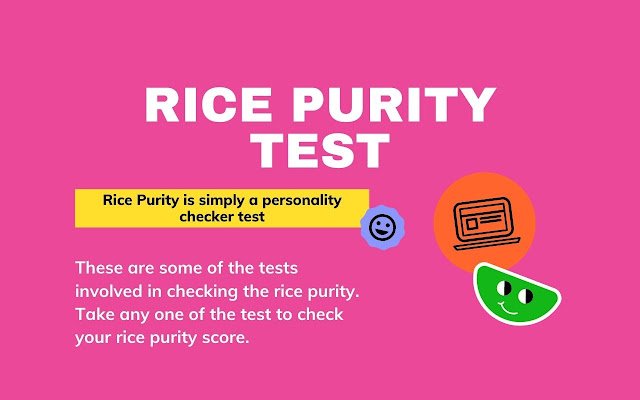“What’s your rice purity score?” It’s a question that’s become a cultural rite of passage for many young adults and college students. As we navigate the complexities of modern life, the Rice Purity Test offers a curious lens into our behaviors and values, sparking discussions on everything from personal experiences to social norms.
Introduction
Welcome to our deep dive into the Rice Purity Test—a captivating phenomenon that has intrigued young adults and college students for decades. This post will unpack the test’s history, its structure, its cultural impact, and more. Whether you’re a first-timer or have taken it several times, this comprehensive guide will provide you with all you need to know about the Rice Purity Test.
History and Origin
The Rice Purity Test has an illustrious past that dates back to the 1930s at Rice University in Houston, Texas. Initially conceived as a way for students to bond and share their life experiences, the test has evolved significantly over the years.
Originally, the test was a paper checklist of various life experiences and behaviors, which students would fill out to gauge their level of “purity.” This early version of the test played a role in fostering a sense of community among students by encouraging openness and discussions about personal milestones and adventures.
Over time, the test has moved online, making it more accessible and widely known, and it continues to be a popular means for individuals to reflect on their life choices and experiences in a light-hearted manner.
Potential Improvements to the Test
While the Rice Purity Test has maintained its popularity over the years, there are several ways it could be improved to better reflect modern sensibilities and address criticisms. One potential enhancement is the inclusion of more diverse and updated questions that resonate with today’s young adults. As societal norms and experiences evolve, the test could adapt to better capture contemporary behaviors and milestones.
Another improvement could be the introduction of a scoring system that is more nuanced and less binary. Currently, the test’s results can sometimes perpetuate judgmental attitudes, placing individuals on a purity scale that may feel restrictive or unfair. By implementing a more gradated scoring system, participants might gain deeper insights into their experiences without feeling labeled or boxed in.
Additionally, the test could benefit from more inclusive language and scenarios that consider the varied backgrounds and experiences of a broader demographic. Expanding the test’s inclusivity would ensure that it resonates with a wider audience, making it a more universal tool for reflection.
Finally, incorporating educational elements within the test could boost its value. For example, providing context or resources about certain behaviors can foster a more informed understanding for participants, making the test not just a fun activity, but also a learning experience.
Structure and Scoring
At its core, the Rice Purity Test is a 100-question survey that covers a wide range of life experiences, including relationships, behaviors, and activities. Participants start with a perfect score of 100 points. For each question answered affirmatively, points are deducted, resulting in a lower overall score. The final score serves as an indicator of one’s “purity,” with higher scores reflecting fewer life experiences and lower scores indicating more.
Key Sections of the Test
- Relationships and Dating
- Substance Use
- Academic Integrity
- Law and Order
Cultural Significance of Rice Purity
Why has the Rice Purity Test gained such immense popularity? One reason is its role as a social tool. The test provides a structured way for individuals to reflect on their experiences while also serving as a conversation starter in social circles. In college dorms and online communities, sharing Rice Purity scores has become a fun, albeit sometimes revealing, activity.
Psychology and Motivations
What drives people to take the Rice Purity Test? The motivations are varied:
- Curiosity about how one’s experiences compare to peers.
- Self-reflection on one’s personal growth and past decisions.
- Peer pressure to participate in a trending activity.
At its heart, the test taps into our innate desire to understand ourselves and others better.
Social Media’s Influence
The digital age has propelled the Rice Purity Test to new heights. Platforms like TikTok, Twitter, and Instagram have played crucial roles in its resurgence. Hashtags like #ricepuritytest and #purityscore trend regularly, with users sharing their scores and reactions. Social media has not only amplified the test’s reach but also added layers of communal engagement and validation.
Criticisms and Limitations
Despite its popularity, the Rice Purity Test is not without criticism:
- Accuracy concerns due to its broad and sometimes vague questions.
- Potential for shaming behaviors if scores are shared publicly.
- Cultural bias, as the test may not be inclusive of diverse life experiences.
These criticisms highlight the need to approach the test with a grain of salt and an understanding of its limitations.
Interpreting and Discussing Results
Scored lower than your friends? Don’t fret. Here are some tips for interpreting and discussing your results:
- Focus on self-reflection rather than comparison.
- Use the test as a starting point for meaningful conversations.
- Remember that a score doesn’t define your worth or experiences.
Impact on Mental Health
The Rice Purity Test, like many online quizzes and social tools, can have both positive and negative effects on mental health. On the positive side, the test can serve as a means of self-discovery and reflection, encouraging individuals to contemplate their life choices and personal growth. For some, it offers a sense of belonging and connection, especially when shared within a supportive community. However, there are potential downsides to consider.
The emphasis on comparing scores can lead to feelings of inadequacy and self-judgment, particularly if one scores significantly lower or higher than peers. This comparison can exacerbate existing mental health issues such as anxiety, depression, or low self-esteem. Additionally, the test’s focus on certain experiences might inadvertently shame or stigmatize individuals who have had different life paths, further impacting their mental well-being.
It is crucial to approach the Rice Purity Test with a balanced perspective, understanding that it is a simple tool meant for fun and reflection, rather than a definitive measure of one’s worth or character.
Mental Health Considerations
It’s essential to approach the Rice Purity Test with a healthy mindset. While it can be a fun and lighthearted activity, it’s important not to place too much weight on the results. Remember, the test is just a series of questions meant to gauge various life experiences and doesn’t define your worth or character.
If you find that taking the test or discussing your score impacts your mental well-being, consider taking a step back. Reflect on why you are feeling this way and remind yourself that everyone has different experiences and timelines. It’s perfectly okay to share your thoughts with a trusted friend or a mental health professional who can provide support and perspective. Prioritizing your mental health should always come first.
Future Trends and Changes
The future of the Rice Purity Test is as dynamic as its past. Potential updates could include more inclusive questions that better reflect diverse experiences, ensuring that individuals from all backgrounds feel represented. This could involve adding questions that consider different cultural contexts, lifestyles, and personal choices.
Additionally, as social norms evolve and society becomes more open to discussing topics previously considered taboo, the test’s relevance may shift, adapting to the changing landscape of young adult life. This ongoing adaptation ensures the test remains a valuable tool for self-reflection and understanding among young adults.
Controversies and Debates of Rice Purity Test
The Rice Purity Test, while engaging and popular, is not without its share of controversies and debates. A prominent point of contention is its binary nature of question framing, which some argue oversimplifies complex human experiences. For instance, questions may not account for the nuances of consensual non-monogamy or diverse sexual orientations, thus alienating or misrepresenting certain groups. Additionally, there is a concern over the potential for reinforcing harmful stereotypes or norms, particularly around subjects like substance use, sexual behavior, and legal infractions.
Another major debate centers around the issue of privacy and data sharing. In the digital age, many users are wary of how their responses might be used or stored, especially when engaging with online platforms. This concern ties into larger conversations about cyber security and digital consent. Furthermore, cultural critics have pointed out that the test may inadvertently promote a culture of shaming or judgment, particularly if scores are used to ostracize or ridicule peers.
The elitist undertones in the origins of the test also draw criticism. As the test first emerged from a specific college environment, its questions are seen to reflect a certain socio-economic experience, potentially marginalizing those from different backgrounds. This brings up broader discussions about inclusivity and representation in social norms and practices.
Ultimately, while the Rice Purity Test remains a compelling and entertaining tool for many, it is crucial to approach it with a critical eye and an appreciation for the diverse experiences that shape individual lives.
Conclusion
The Rice Purity Test remains a fascinating cultural barometer for young adults. It offers a unique and engaging way to explore and discuss personal experiences, all while fostering a sense of community and understanding among peers. This test, which covers a wide range of life events and behaviors, can serve as a starting point for meaningful conversations about personal values, boundaries, and life choices.
Whether you’re taking it for the first time or revisiting it with friends, remember that the value of the Rice Purity Test lies not in the score itself, but in the self-reflection and open discussions it can prompt. It’s an opportunity to gain insight into your own experiences and those of others, promoting a deeper sense of empathy and connection.
Ready to explore your own Rice Purity score? Take the test and join the conversation today. For personalized insights and engaging discussions, feel free to book a call with one of our experts. They can provide further context, answer any questions you might have, and help you navigate the complexities of your personal experiences.





